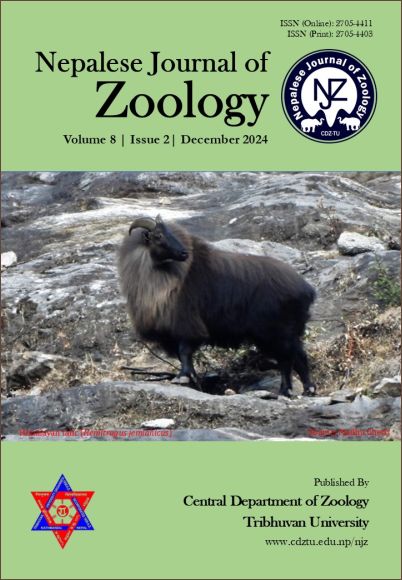Gastrointestinal parasites among Musahar Community in Balan-Bihul, Saptari, Nepal
DOI:
https://doi.org/10.3126/njz.v8i2.74933Keywords:
Ancylostoma, Blastocystis, Game meat, Hymenolepis, MusaharAbstract
Gastrointestinal parasites inhabiting the intestinal tract can directly or indirectly affect the growth, well-being, and survival of hosts, including humans. In this context, the Musahar, highly marginalized ethnic tribes with existing discrepancies, like illiteracy, low socio-economic conditions, and lack of awareness concerning healthy hygienic practices, may be at an increased risk of infectious parasitic diseases. Therefore, the current aim is to determine the diversity and frequency of gastrointestinal parasites among the Musahar residing in the Saptari district in eastern Nepal. Using purposive sampling and non-invasive techniques 200 fresh fecal samples and epidemiological data for microscopic examination and identification of risk factors were collected. The coproscopy was carried out using direct wet mount and concentration techniques. The results showed an 81% (162/200) prevalence and the presence of nine different species of parasites, including Ancylostoma sp. (41.5%), Ascaris lumbricoides (29%), Entamoeba sp. (31.5%), Entamoeba coli (21.5%), Trichuris trichuria (16%), Strongyloides stercoralis (8.5%), Giardia sp. (7%), Hymenolepis nana (14%), and Blastocystis sp. (2%). The prevalence of helminths (67%) was higher than that of single-celled protozoa (42%). Furthermore, parasitism was significantly higher among individuals who consumed game meat, defecated in open spaces, lived in mud homes, and had an unknown history of medication. In conclusion, the Musahar community exhibits a higher prevalence of gastrointestinal parasites. Therefore, implementing community-based health awareness programs concerning the cause, transmission route, effects as well as preventive measures for parasitism is highly recommended. In addition, the One Health study approach is essential to address the root causes of parasite transmission and ways to prevent them.
Downloads
Downloads
Published
How to Cite
Issue
Section
License
Copyright (c) 2024 The Author(s)

This work is licensed under a Creative Commons Attribution-NonCommercial 4.0 International License.
This license enables reusers to distribute, remix, adapt, and build upon the material in any medium or format for noncommercial purposes only, and only so long as attribution is given to the creator.

